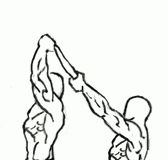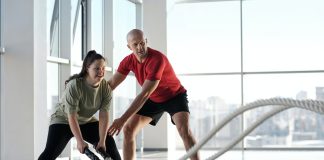Last Updated on September 30, 2014
The front squat to bench with barbells is an excellent alternative to traditional squats, particularly for those who want to reduce the load on their back and neck. This variation places the barbell on the front of your body, allowing you to maintain an upright posture and engage your core muscles effectively. The bench serves as a guide, helping ensure you squat to the correct depth while maintaining proper form.
Whether you’re a beginner or an experienced lifter, this exercise can be a valuable addition to your workout routine. In this guide, we’ll dive into the benefits of the front squat, how to perform it correctly, tips for avoiding common mistakes, variations for different fitness levels, and safety considerations.
Benefits of the Front Squat to Bench with Barbells
The front squat is more than just an alternative to the rear squat; it comes with its own set of benefits that make it an effective and versatile exercise:
- Reduced Strain on the Lower Back and Neck: By positioning the barbell on the front deltoids rather than the upper back, the front squat shifts the center of gravity. This adjustment places less pressure on the spine, making it a safer option for those with back or neck concerns.
- Enhanced Core Engagement: The front squat forces you to maintain an upright posture, which requires significant core stabilization. This is beneficial not only for developing strong abs but also for improving overall balance and stability.
- Improved Quadriceps Activation: Front squats place a greater emphasis on the quadriceps compared to back squats, as the more vertical torso position shifts the load forward. This makes it an excellent exercise for developing leg strength and muscle definition.
- Correct Depth Control with the Bench: Using a bench as a guide ensures you are squatting to the correct depth, which can help maintain proper form, especially for beginners. It also provides a consistent target, so you can track and improve your squat depth over time.
- Versatility and Progression: The front squat is highly versatile, with options to modify the exercise based on your fitness level. From bodyweight variations to using different equipment like kettlebells or resistance bands, you can adjust the intensity and complexity to fit your goals.
Muscles Worked During the Front Squat to Bench Exercise
The front squat is a compound exercise, meaning it works multiple muscle groups simultaneously. Here are the primary muscles engaged:
- Quadriceps: The front squat heavily targets the quadriceps, as they are responsible for the movement of extending the knee during the squat.
- Hamstrings and Glutes: These muscles work as stabilizers and help control the lowering phase of the squat.
- Core Muscles: The abs and obliques are activated to maintain balance and stability, particularly when keeping an upright posture.
- Calves: The calves assist in stabilizing the lower leg and ankle during the squat movement.
- Upper Back and Shoulders: The upper body muscles, especially the deltoids and traps, work to hold the barbell in place and stabilize the torso.
Step-by-Step Guide to Performing the Front Squat to Bench
Achieving proper form is essential for maximizing the benefits of the front squat while minimizing the risk of injury. Follow these detailed steps to perform the exercise correctly:
- Set Up the Bench and Barbell: Position a bench behind you, ensuring it’s in the correct spot to serve as a depth guide for your squats. Load the barbell with an appropriate weight on a squat rack and stand in front of it.
- Position the Barbell: Step up to the bar and rest it across your upper chest, placing it on the front deltoids. Cross your arms over the bar, securing it with your fingers. Alternatively, you can use the “clean grip” if you have the wrist flexibility, keeping your elbows high to create a stable platform for the bar.
- Stand Tall: Lift the bar off the rack and take a step back. Keep your feet shoulder-width apart with your toes pointing slightly outward. Engage your core, pull your shoulders back, and maintain a neutral spine.
- Initiate the Squat: Slowly bend your knees and hips as you lower your body. Aim to bring your upper thighs parallel to the floor, stopping just before you reach the bench. Remember, the bench is a guide—do not sit down on it.
- Return to Starting Position: Push through your heels and extend your legs to return to the starting position. Keep your torso upright and your core engaged throughout the movement.
- Repeat: Perform the desired number of repetitions while maintaining proper form. Start with lighter weight or just the bar to practice before adding heavier loads.
Tips for Proper Form and Technique
Maintaining proper form is crucial for preventing injury and maximizing muscle engagement. Here are some key tips to remember:
- Warm Up Thoroughly: Begin with a dynamic warm-up, focusing on hip mobility exercises, leg swings, and bodyweight squats. This will prepare your muscles and joints for the exercise, reducing the risk of injury.
- Keep Your Core Engaged: Drawing your abs in and keeping your core tight will help stabilize your spine and maintain an upright position. This is especially important when using heavier weights.
- Maintain an Upright Posture: Avoid leaning forward or rounding your back. Your chest should remain lifted, and your gaze should be straight ahead or slightly upward to help with balance.
- Control the Descent: Lower yourself slowly and with control. A controlled descent ensures that you activate the right muscles and minimizes the risk of “crashing” onto the bench.
- Don’t Sit on the Bench: The bench serves as a depth guide, not a seat. Make sure you stop just before touching it and immediately start your upward movement. Sitting on the bench can disrupt your form and increase injury risk.
Common Mistakes and How to Avoid Them
Even with the best intentions, some common mistakes can occur during the front squat. Here’s how to identify and correct them:
- Rounding the Back: Leaning forward or rounding your back puts unnecessary strain on your spine. To avoid this, focus on keeping your chest lifted and engaging your core.
- Dropping the Elbows: Keeping the elbows high and in line with your shoulders helps stabilize the barbell. Dropping them can cause the bar to slide forward, leading to poor form or even injury.
- Using Momentum: Avoid rushing through the movement or bouncing off the bench. Instead, focus on a controlled descent and ascent to fully engage the muscles and prevent strain.
- Incorrect Foot Placement: Placing your feet too close or too wide can affect balance and muscle engagement. Aim for shoulder-width stance with toes pointing slightly outward to ensure proper alignment.
- Neglecting Core Engagement: A weak core leads to instability. Draw in your abs throughout the entire movement to protect your back and maintain balance.
Variations of the Front Squat to Bench
To keep your workouts dynamic and adapt the exercise to your fitness level, try incorporating these variations:
- Bodyweight Front Squat to Bench: This is a great starting point for beginners. Focus on form and control without any added weight until you feel comfortable progressing to the barbell.
- Kettlebell Front Squat to Bench: Hold a kettlebell in the front rack position (close to your chest) as you squat. This variation allows you to practice the movement with a different weight distribution and challenges your core stability.
- Goblet Squat to Bench: Hold a dumbbell or kettlebell with both hands in front of your chest. This version is perfect for those who prefer using free weights and is a great way to build up strength before advancing to a barbell.
- Resistance Band Front Squat: Step on a resistance band with your feet shoulder-width apart, holding the band handles at shoulder height. This option is ideal for home workouts and provides variable resistance throughout the squat.
- Single-Arm Dumbbell Front Squat: Hold a dumbbell in one hand and squat with it in front of your shoulder. This variation challenges balance and requires greater core activation.
Programming Front Squats Into Your Routine
Front squats can be integrated into various types of workout programs, whether you are focusing on strength, muscle building, or functional fitness. Here’s how you can include them:
- Strength Training: Incorporate front squats as part of your lower body day or full-body routine. Perform 3-4 sets of 6-8 reps with heavier weights, focusing on controlled movements and proper form.
- Muscle Building (Hypertrophy): For those aiming to build muscle, aim for 3-4 sets of 8-12 reps with moderate weight. Keep rest periods between 60-90 seconds to maintain intensity.
- Functional Fitness or Conditioning: Use lighter weights and perform higher reps (12-15) for 3 sets. You can also include front squats in a circuit, pairing them with other lower-body exercises like lunges and calf raises.
Safety Considerations
Safety should always be a priority when performing any weight-bearing exercise, especially squats. Here are some key safety considerations for the front squat:
- Warm-Up: Never skip the warm-up. A good warm-up prepares your muscles and joints, increasing mobility and reducing the risk of injury.
- Start Light: Begin with an empty bar or even just your body weight to practice the movement. Only add weight when you feel confident in your form.
- Use a Spotter or Safety Bars: When lifting heavier weights, it’s wise to use a spotter or set up safety bars on the squat rack. This way, if you lose balance or cannot complete the lift, the safety bars or spotter can help you avoid injury.
- Wear Proper Footwear: Lifting shoes or flat, stable shoes provide the support needed for squats. Avoid soft or cushioned shoes, as they can cause instability.
- Avoid Overloading the Bar: Only increase the weight when you are confident in your form and have mastered the technique. It’s better to progress gradually than risk injury by lifting too much too soon.
- Listen to Your Body: If you feel any discomfort in your knees, back, or shoulders, stop the exercise and assess your form. Pushing through pain can lead to serious injuries, so always prioritize your health.
Frequently Asked Questions About Front Squat to Bench
1. Is the front squat to bench suitable for beginners?
Yes, this exercise is great for beginners. Using the bench as a depth guide helps ensure proper form, making it easier for new lifters to develop the right technique. Beginners should start with body weight or light weights to build confidence and muscle memory.
2. How often should I incorporate front squats into my routine?
Front squats can be done 1-2 times a week, depending on your overall workout program. Make sure to allow at least 48 hours between leg workouts to give your muscles time to recover and grow.
3. Can front squats replace back squats in my program?
Front squats can be a good substitute for back squats, especially if you have issues with back pain or want to emphasize your quadriceps more. However, for a well-rounded lower-body development, incorporating both front and back squats (if your body allows) can be beneficial.
4. Is it normal to feel pressure on my wrists during front squats?
Yes, the traditional front squat grip can put pressure on your wrists, especially if you lack flexibility. You can use a crossed-arm grip instead of the clean grip to reduce the strain, or work on improving your wrist flexibility over time.
5. Should I pause when I reach the bench during the squat?
No, you should not pause or sit on the bench. The bench is meant to be a guide for your depth, so touch it lightly and immediately begin the upward motion. Pausing or sitting can disrupt your form and cause unnecessary strain on your joints.
The front squat to bench with barbells is an effective and versatile exercise that offers numerous benefits for both beginners and advanced athletes. By emphasizing proper form, engaging the core, and using the bench as a guide, this variation provides a safe way to build strength and muscle in the lower body without placing undue stress on the spine.
Remember, consistency and form are key. Whether you are looking to build strength, increase muscle mass, or improve overall fitness, incorporating the front squat into your routine can be a game-changer. Start light, focus on technique, and progressively increase the weight as you gain confidence and strength. With the right approach, the front squat to bench can become a staple in your training program, helping you achieve your fitness goals safely and effectively.to become comfortable with the movements. Do not sit on the bench during the exercise.
Exercise images by Everkinetic.






